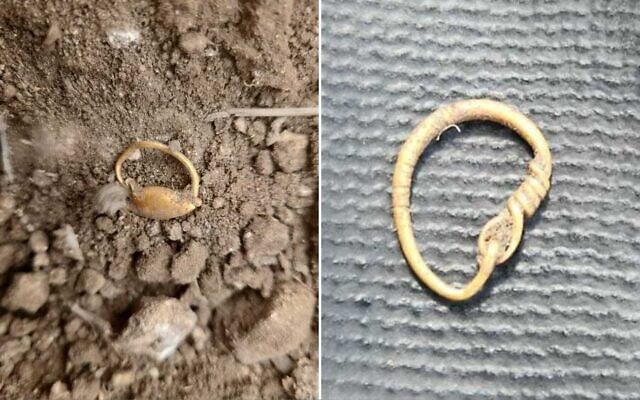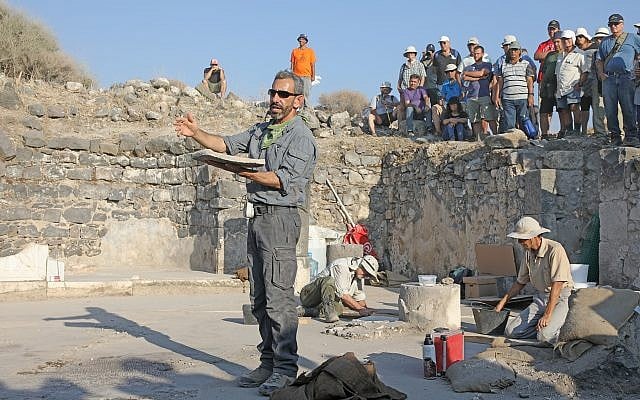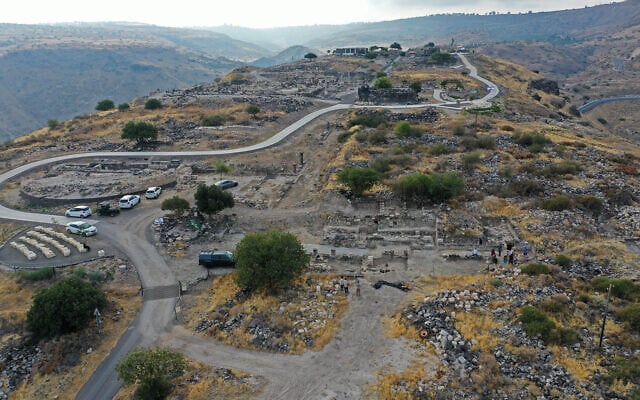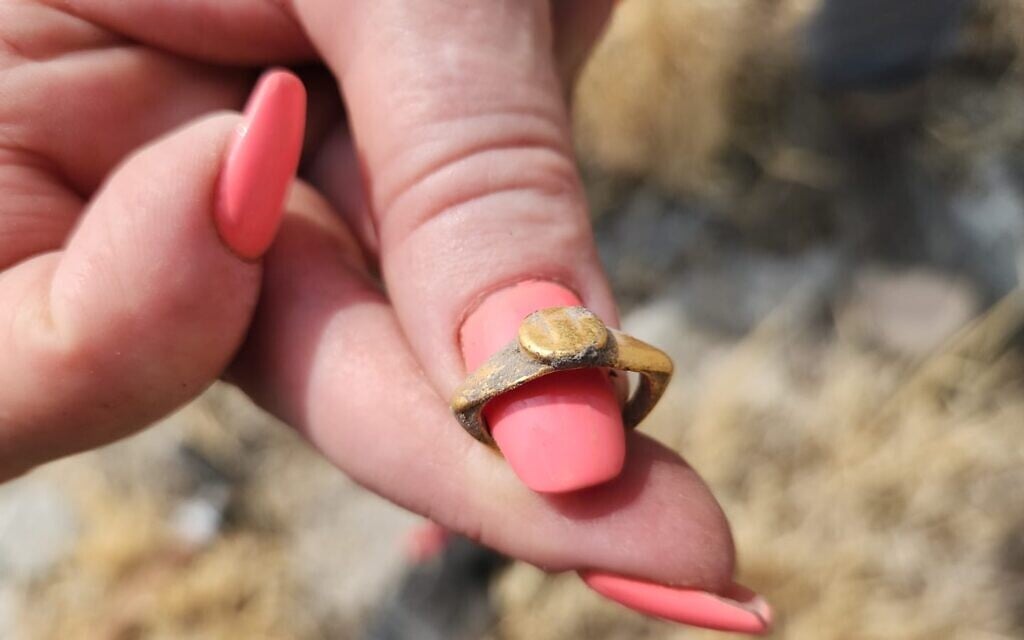High above the eastern shore of the Sea of Galilee, where ancient basalt stones still bear witness to nearly two millennia of history, archaeologists have uncovered extraordinary golden treasures that transport us back to the time of Jesus’ ministry. At Sussita National Park—known in antiquity by its Greek name Hippos—a delicate gold ring and exquisite earrings from the Roman period (1st-3rd centuries CE) have emerged from the earth, offering tangible connections to the biblical world.

Roman-era gold earrings found during archaeological excavations at the Sussita (Hippos) National Park in 2025. (Eddy Lipsman)
The recent discoveries, announced by the Israel Nature and Parks Authority, represent more than mere archaeological artifacts—they are windows into the affluent society that Jesus himself may have encountered during his ministry in the Decapolis region. Dr. Michael Eisenberg, co-director of the Hippos (Sussita) Excavations Project with Dr. Arleta Kowalewska from the University of Haifa, believes these golden objects tell a story of remarkable wealth and sophistication.

Archaeologist Dr. Michael Eisenberg, dig director of the Hippos-Sussita Excavation Project, at the Susita National Park, summer 2019. (Courtesy)
“The tiny, heavy gold ring must have been lost by a daughter of a wealthy family in Sussita,” Eisenberg explained. The ring, discovered in a residential neighborhood currently under excavation, likely belonged to a young girl who perhaps played in the very streets where, according to biblical chronology, Jesus may have walked. “In light of its size, the ring must have belonged to a little girl, who probably lost it,” he speculated with archaeological empathy. “I hope she was not punished for it.”
The accompanying earrings, found near the Roman necropolis, were likely intended as burial offerings but were discovered outside the tombs—fortuitously escaping the attention of ancient grave robbers. Both discoveries were made by the same volunteer, Eddie Lipsman, whose metal detector revealed these precious remnants of a biblical-era civilization.
The significance of these finds extends far beyond their material value. Sussita was one of the ten cities of the Decapolis alliance, explicitly mentioned in the Gospels as a region where Jesus preached and ministered. Matthew’s Gospel records: “Jesus went throughout Galilee, teaching in their synagogues, proclaiming the good news of the kingdom, and healing every disease and sickness among the people. Large crowds from Galilee, the Decapolis, Jerusalem, Judea, and the region across the Jordan followed him” (Matthew 4:23-25).

An aerial view of the Sussita (Hippos) National Park in the eastern Galilee. (Michael Eisenberg)
Recent archaeological work has revealed that the main streets of Sussita—paved with basalt blocks and including the grand Decumanus Maximus (the east-west thoroughfare) and the Cardo (the north-south street)—date precisely to the time of Jesus’ earthly ministry in the first century CE. “Based on pottery, coins, and stratigraphy,” Eisenberg noted, “these streets are dated not later than the middle of the 1st century CE.”
“Without exaggerating, Jesus probably walked on those basalt slabs, and if not on the slabs, on the plaster under them,” the archaeologist added, offering Christians a profound connection to the physical world their Savior inhabited.
Founded by the Greek Seleucids in the 2nd century BCE on the eastern shore of the Sea of Galilee, Hippos flourished as a major urban center during the Roman and Byzantine periods. The city’s name, meaning “horse” in both Greek and Hebrew, is reflected in its ancient emblems and coins. Archaeological evidence reveals a sophisticated Greco-Roman metropolis complete with a colonnaded main street, rectangular forum, Roman fortifications, luxurious public baths, and major temples.
The wealth evidenced by the golden artifacts aligns with other discoveries that paint a picture of remarkable prosperity. Excavations have revealed massive monolithic shafts of granite and marble imported from Egypt, Asia Minor, and the Greek islands. Elaborate mausolea, “a few stories high, with magnificent decorations, sculptured flowers, the best artisanship in basalt that we have in the land of Israel,” demonstrate the financial capabilities of Sussita’s elite residents.
This archaeological evidence provides important context for understanding the Decapolis as Jesus encountered it—not as modest rural communities, but as sophisticated urban centers with considerable wealth and international connections.
While Sussita began as a pagan Hellenistic city, it underwent a remarkable transformation that mirrors the spread of Christianity throughout the Roman Empire. Archaeological evidence documents the city’s evolution from its pagan origins—including discoveries of a rare bronze Pan mask and Hellenistic sanctuaries—to becoming a major Christian center during the Byzantine period.
By the 6th century CE, Sussita had become one of the most important Christian cities in the region, featuring at least seven churches, including a magnificent cathedral. The city served as the seat of a bishop (Episcopus), and its Christian character is evidenced by elaborate Byzantine mosaics, inscriptions, and church architecture that archaeologists continue to uncover.
“Many people today are not aware that Hippos was a main Christian city in Byzantine times, with the best panoramic view of Jesus’ ministry,” Eisenberg observed. From its elevated position, Christian pilgrims and residents could gaze across the Sea of Galilee toward Capernaum, Bethsaida, and other sites central to Jesus’ Galilean ministry.
Among the most significant biblical discoveries at Sussita is the Byzantine cathedral, which archaeologists believe played an exceptionally important role in early Christian practice. Unlike other early Christian churches in the region that featured modest baptismal fonts, the Sussita cathedral included a photisterion—an entire baptistery hall—suggesting the large-scale administration of baptisms.
This architectural feature points to Sussita’s role as a regional Christian center, likely serving surrounding communities along the eastern shore of the Sea of Galilee and the Golan Heights. The cathedral’s construction represents the fulfillment of Jesus’ Great Commission, as the Gospel took root and flourished in the very regions where he had ministered centuries earlier.
The archaeological record at Sussita provides remarkable corroboration for biblical accounts of the Decapolis region. The city’s Roman-period infrastructure, dating to the first century CE, confirms the sophisticated urban environment described in the Gospels. The presence of both Jewish and Gentile populations, evidenced by diverse burial practices and material culture, reflects the multicultural setting of Jesus’ ministry.
The discovery of the Roman necropolis—described by Eisenberg as “one of the most complete, beautiful, and diverse Roman-period necropolises in Israel”—includes burials ranging from simple pit graves of the poor to elaborate basalt mausolea of the wealthy. This diversity echoes the varied audiences Jesus addressed, from tax collectors and fishermen to wealthy individuals and Roman officials.
Ironically, the remarkable preservation of Sussita’s biblical-era remains resulted from tragedy. A devastating earthquake in 749 CE leveled the city, which was then permanently abandoned. This catastrophic end paradoxically became archaeology’s gain, preserving structures, artifacts, and street layouts virtually unchanged since the Byzantine period.
The earthquake layers also provide evidence for earlier seismic events, including damage from a 4th-century earthquake that affected many Galilean sites. These geological markers help archaeologists establish precise chronologies for understanding the city’s development through the Roman and Byzantine periods.
The current excavation season, supported by a government research grant and the dedication of international volunteers, continues to yield discoveries that illuminate biblical history. The 2025 season focuses on exposing residential quarters, ancient cemeteries, the Roman cathedral, and a recently uncovered monumental gate.
Volunteers from around the world, including returning participants who make annual pilgrimages to participate in the excavations, contribute to uncovering this biblical treasure trove. Their work, continuing despite regional challenges, demonstrates the enduring appeal of connecting with the physical world of Scripture.
The golden ring and earrings from Sussita represent more than archaeological curiosities—they are tangible links to the world Jesus knew and the people he encountered. The wealthy family who could afford such golden ornaments, the skilled craftsmen who created them, and the bustling city where they were worn and lost all formed part of the human landscape of the Gospels.
For Christian visitors and pilgrims, Sussita offers something unique: the opportunity to walk on streets that Jesus himself may have traversed, to stand where early Christians built magnificent churches, and to see the very region from which “large crowds from the Decapolis” followed him. The site, opened to the public in 2023, provides what Eisenberg calls “the best panoramic view of Jesus’ ministry.”
As archaeologists continue their careful work of excavation and conservation, each discovery adds another piece to our understanding of the biblical world. The golden treasures of Sussita remind us that the Gospel accounts describe real places, real people, and real events—and that sometimes, after nearly two millennia, these ancient witnesses still speak to us from the earth itself.
The excavations at Sussita continue to bridge the gap between faith and history, between the biblical text and the material world in which those sacred events unfolded. In the gleaming gold of a child’s lost ring and the careful craftsmanship of burial earrings, we glimpse not just ancient wealth, but the human faces behind the Gospel accounts—the crowds who followed Jesus, the communities that embraced his message, and the civilization that was forever changed by his ministry along the shores of the Sea of Galilee.




